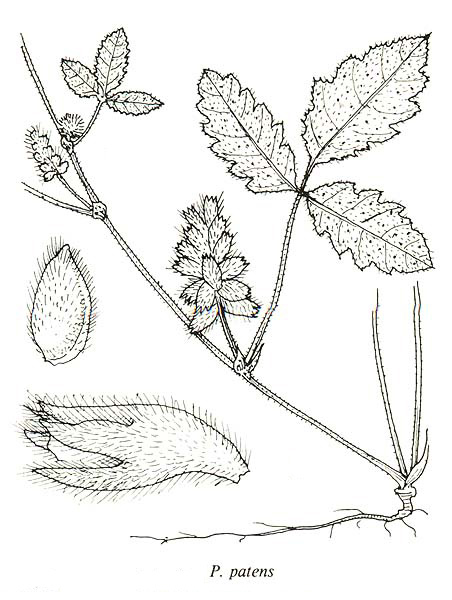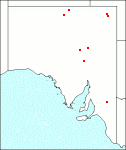Family: Fabaceae
Psoralea patens
Citation:
Lindley in T.L. Mitchell, Three Exped. Int. eastern Austral. 2:8 (1838).
Synonymy: P. eriantha sensu J. Black, Fl. S. Aust. 464 (1948), partly, non Benth.
Common name: Native verbine, spreading psoralea.
Description:
Herbaceous perhaps biennial or perennial, prostrate rarely erect, green or greyish in atypical forms; branches 20-100 x 1.5-2.5 mm, brown-grey, striate lengthwise, grey-pubescent, without visible glands; leaves 3-10 cm long, pinnately 3-foliolate, petioles 1-5 cm long, villous; leaflets rhomboid-ovate, obtuse, denticulate, with veins ending in a small mucro, glabrous or hoary above, usually more pubescent below more so on veins (more tomentose in atypical forms), glandular dotted; lateral leaflets subsessile, terminal on 3-15 mm long petiolules, largest, 1-4 x 0.7-3 cm; stipules triangular-lanceolate 2.5-5 mm, yellowish-brown, leathery, tomentose.
Inflorescence continuous, a usually compact cylindrical to subglobose raceme, 12-15 mm diam., very short sometimes almost sessile (mostly S.Aust. forms) to longer, often on a long peduncle, shorter or longer than the leaves; bract ovate-acuminate, 1.5-3.5 ram, light-brown, leathery, gland-dotted, tomentose; peduncle 0.5-4 mm long, rhachis 10-20- rarely more-flowered, 1-9 cm long, usually longer than the peduncle in S.Aust. forms; flowers subsessile, on short villous pedicels, 6-7 mm long, corolla slightly shorter than the calyx (in S.Aust. specimens); calyx more or less tubular, not open in fruit, pubescent with white or pale hairs; tube 1.5-4 mm; 4 upper teeth subequal, lanceolate, 3-6 mm, lowest triangular-lanceolate, 3-7 mm long, broader and usually longer than the others; standard obovate-cuneate, c. 4 mm long, on a long claw, pale-white; wings shorter, oblong, auriculate, long-clavate, white, with the tip often tinted purple; keel obovate-oblong, slightly auriculate, on a long claw, equalling the wings, obtuse, with a distinct purple dot apically.
Pod enclosed within the calyx, ovoid-cylindric, c. 2.5 x c. 1.5 mm, brown, white-villous, indehiscent; seed yellow.

|
|
Image source: fig. 321B in J.P. Jessop and H.R. Toelken Ed. 1986. Flora of South Australia (4th edn).
|
|
|
Distribution:
|
on sandy soils.
all mainland States;.
|
Conservation status:
native
Flowering time: July — Nov.
|

SA Distribution Map based
on current data relating to
specimens held in the
State Herbarium of South Australia
|
Biology:
In S.Aust. specimens the petals are enclosed within the calyx and invisible, except sometimes at the fruiting stage, when the corolla is pushed forward by the enlarging pod after anthesis protruding persistently from the calyx.
Taxonomic notes:
S.Aust. specimens tend to have short subsessile inflorescences described as an atypical form by A. Lee (1980), Telopea 2:137; also the leaves are more tomentose, giving them a greyish-green appearance. There is perhaps an overlap in size of inflorescence and a similarity in flowers with P. pallida which occurs sympatrically and it is difficult, where the inflorescence is on a long peduncle, to distinguish them from one another. These two related species can be further confused when the stem appears pithy-stoutish. To separate P. patens from P. eriantha is very difficult, and A. Lee (1980), Telopea 2:129, is of the opinion that these 2 taxa cannot be separated. Our specimens fit the descriptions of P. patens given by A. Lee and are treated as such accordingly. These 3 major taxa can be recognised, but they lack clear-cut species boundaries, outbreeding does occur in nature and the whole complex appears as a polygenic unit.
Author:
Not yet available
|

